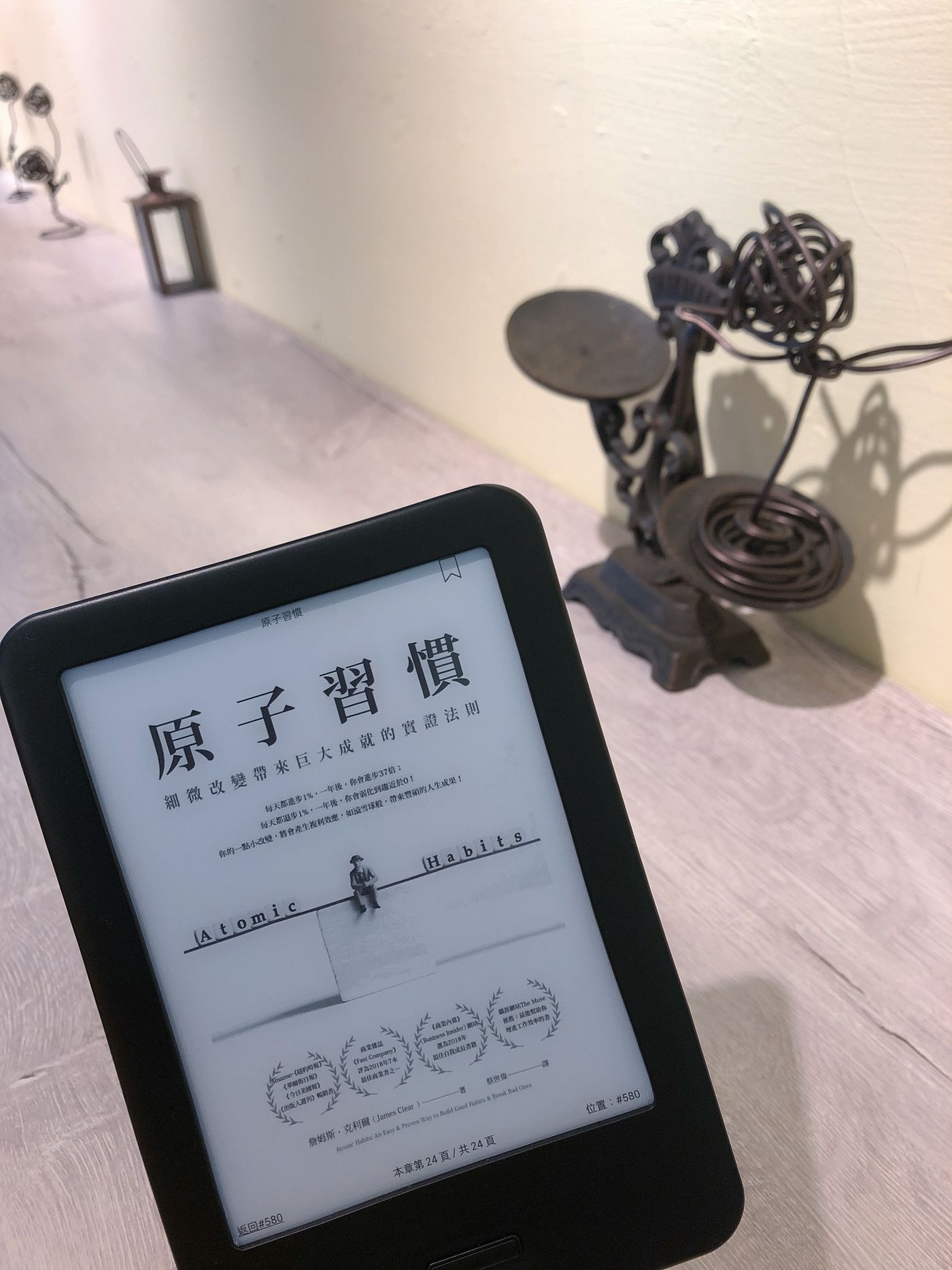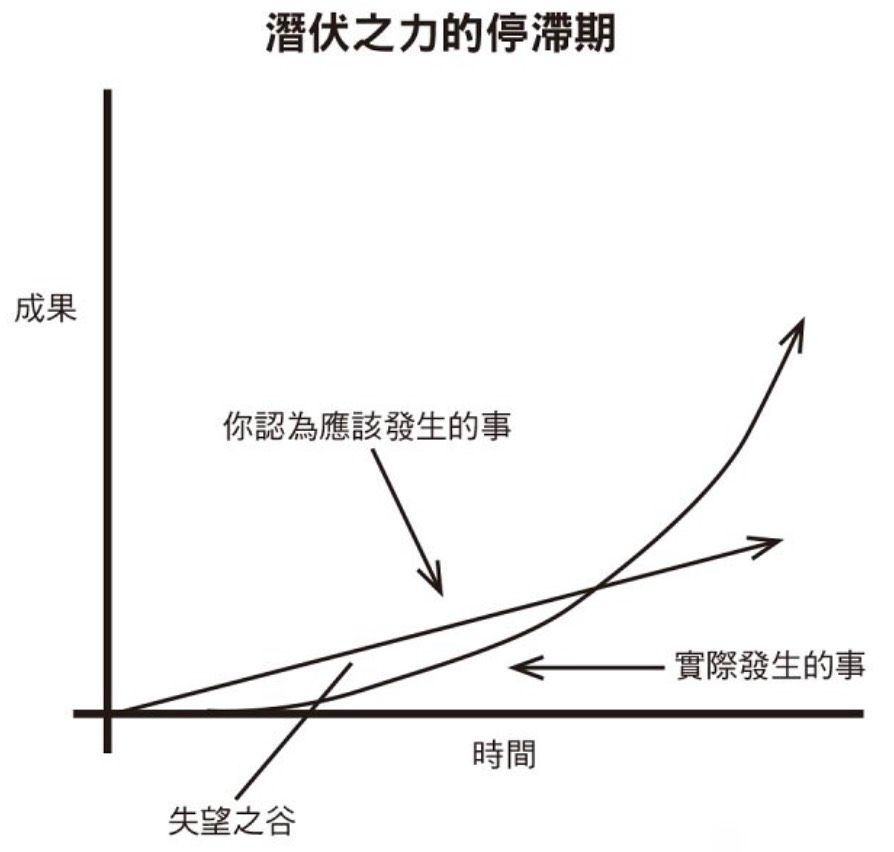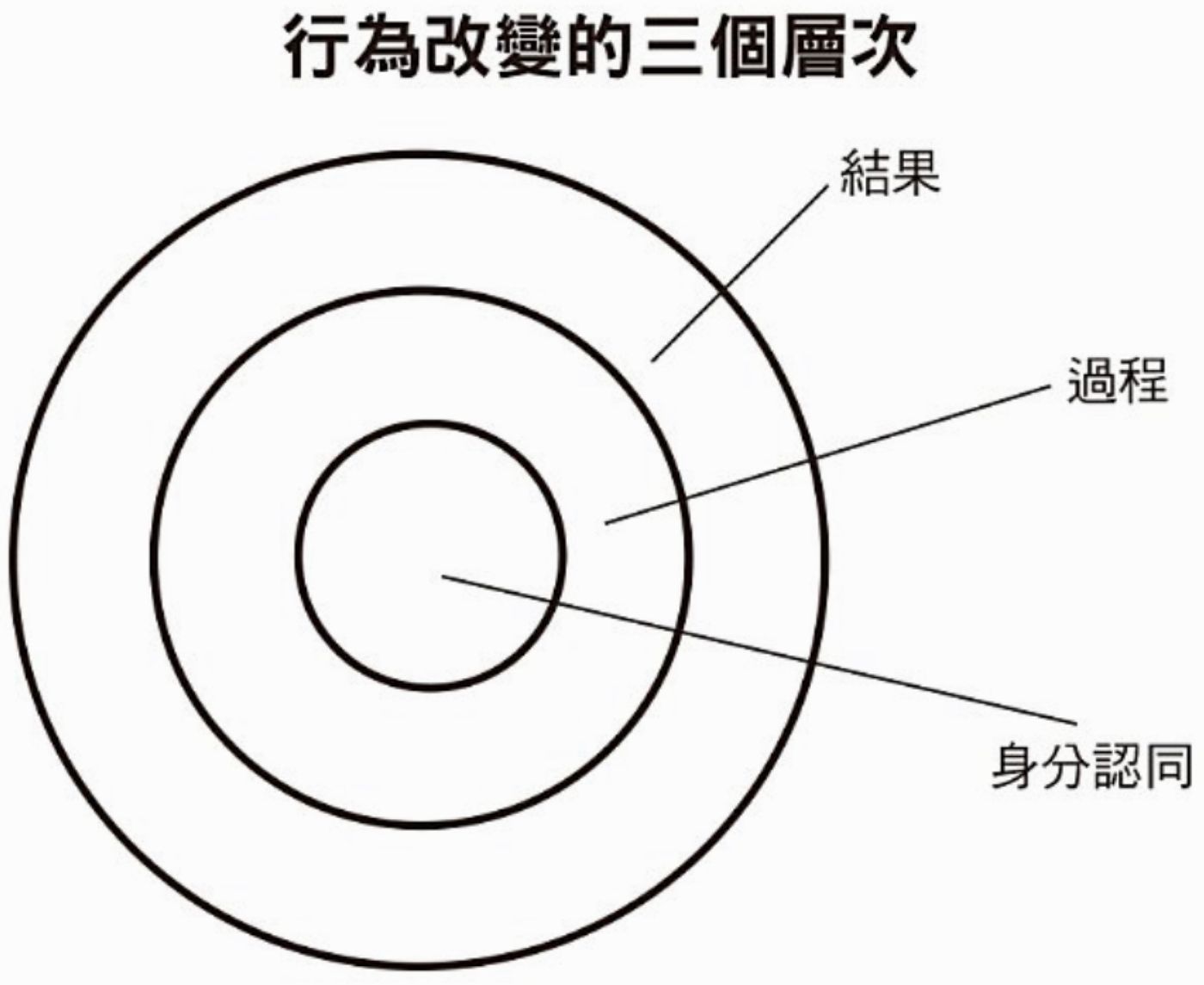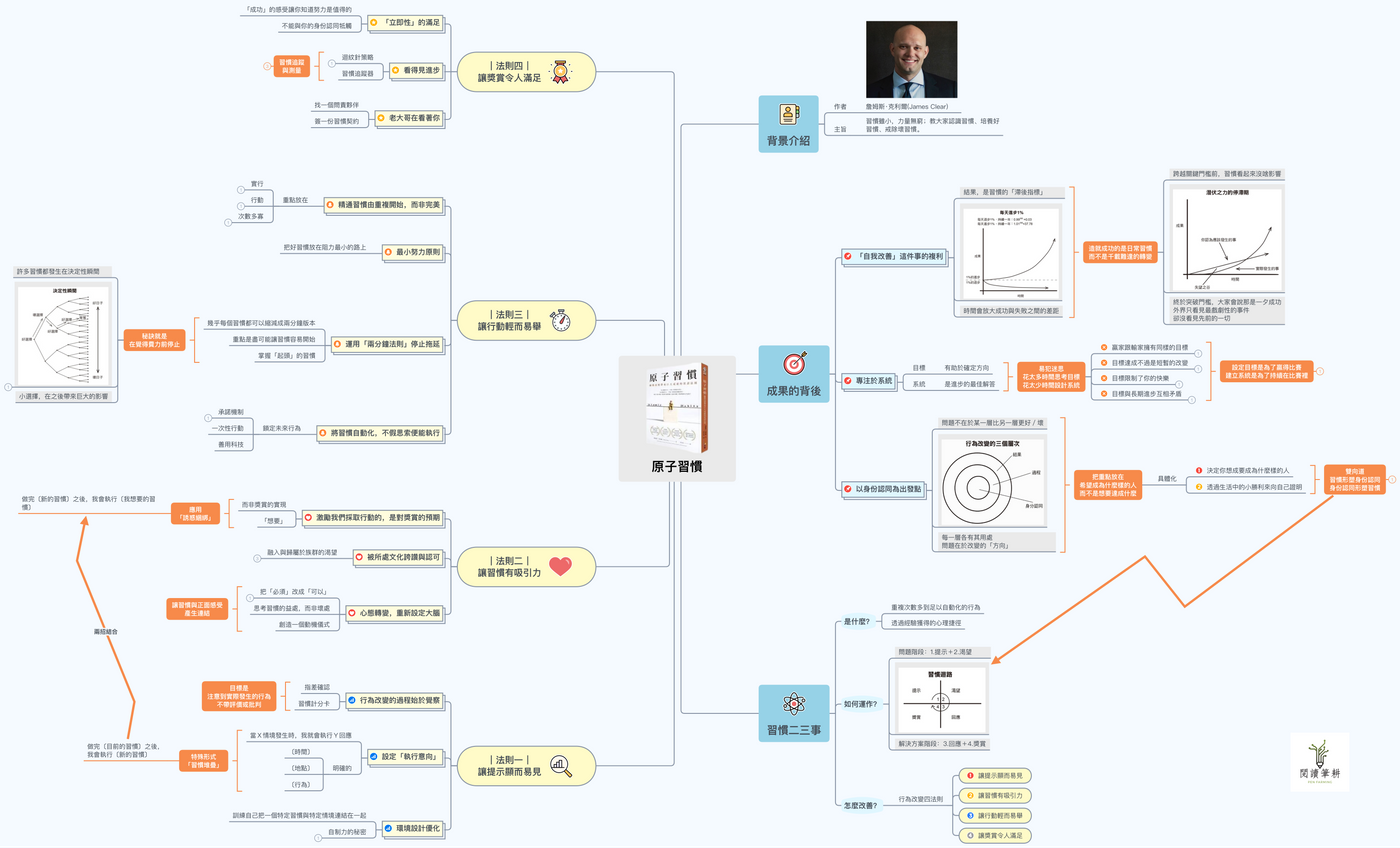The left hand is just a support, see "Atomic Habit" for three pictures
Author: James Clear
Translator: Cai Shiwei Publisher: Fang Zhi

Recently, the "second brush" atomic habit.
This book is so famous that I don't want to be polite anymore. I want to go straight to the point and review it with the three pictures in the book.
■ This chicken soup has a new packaging
The prelude to Atomic Habits cites three examples to lay out the idea that "tiny (atomic) improvements" can stack up to "great results"—with a catalyst for " repetition ."
"Huh! You brought out chicken soup for the soul?"
I think it is, but this chicken soup is put on a new coat of "two-dimensional charts", using scientific thinking to evoke emotional appeals.
⋯
✅ The influence of habits has a compounding effect

Compound interest is commonly known as "returning profits", and when applied to habits, it can be interpreted as " deriving additional benefits ".
As far as reading is concerned, as the amount of reading increases, the background knowledge base of the reader becomes increasingly enriched; in the future, when encountering similar themes, it saves an understanding procedure, and the reading becomes smoother and easier to understand by analogy.
⚠️ And the ruler of time will magnify the compound interest effect, highlighting the gap between success and failure.
⋯
✅ Habits don't seem to matter until you cross the threshold (Valley of Disappointment)

The chart just now remains the same, now add a line called "your expectations".
As a result, there is a gap between expectations and reality, a " valley of disappointment ". Many people failed to pass this level and gave up in the middle, so that they could not fully enjoy the beauty that came after crossing the valley.
I love the parable of the hammering mason in the book. Maybe 100 hits, and there wasn't a single crack in the stone during this " stagnation period of latent power, " but on the 101st hit, the stone broke in two—ah! It wasn't the last " dramatic burst " that split the stone in half, but every previous strike.
⚠️ But everyone will say that it was an overnight success, but did not see everything before.
⋯
✅ Habit formation, from the inside out, it lasts forever

There are three layers of imagination, the result of the outer layer is about what to get , the process in the middle is about what to do , and the identity of the inner layer is about what to believe - the question is not which is better or worse, each level of change has its own use, the key is change direction .
If you want to maintain a habit for a long time, you must start with "identity", make the habit part of "belief", and focus on what you want to be, not what you want to achieve.
"Identity" brings a sense of honor, and the more one is proud of one's own characteristics, the more sub-habits are extended. This is similar to the concept of "Keystone Habits" mentioned in "Habits Get Rich in Practice ". It will allow you to develop additional habits or collaborative habits, and will also eliminate negative habits.
⚠️ Identity is eternal, and the habit of children and mothers will be passed down forever.
■ Two words generate four directions, and four directions account for 80%

This brings homeopathy to the " action reflects identity " argument: what you do suggests who you believe you are, and you believe in a particular aspect of yourself, and you are more likely to act in line with that belief. action.
Like a two-way street, a loop, habit shapes identity, and identity shapes habit —as long as the action is “repeated” enough times.
Based on the above ideas, such a cycle eventually develops into a four-step " habit loop ", which is dismantled individually in sequence, and then derives the four laws of behavior change - which account for 80% of the book, and will be discussed in detail in the appendix at the end of the article.
⚠️ Two nouns: action ⇔ identity ⚠️ Four aspects: prompt, desire, response, reward
The two words are born in four directions, and the four directions account for 80%, which runs through the whole book.
■ Experience: The left hand is just a support

When I read " Atomic Habits " for the first time, I just thought the "Four Laws" were amazing, and I couldn't wait to apply and practice them. After more than a year, when I reviewed it again, I realized something else. This time I have a special understanding of the three layers of "concentric circles" sense.
Once you have calibrated the "personal design", the four rules are like a matching tool - not all of them will come in handy, you can choose what you need more, or even use it subconsciously.
It's not so much to learn the four rules first, follow the map, and then establish a good habit, and later everyone will say that this "movement" is too useful. On the other hand, I tended to have a pure heart and a good habit because of the purity of the mind. After I heard the Four Laws, I became attached to my heart, and my belief was verified by the book .
So, the left hand is just support (assuming you are right-handed), the rule of four is just support, and ultimately you have to rely on your dominant hand to throw the ball, right?
■ Appendix: The Four Laws of Behavior Change
Attached is the organized Mind Map. The book develops the Four Laws of Behavior Change from the "habit loop" - prompt, desire, response, reward - four steps, which are excerpted as follows:

✍️【Rule 1】Make the prompt obvious: clear
The best way to start a new habit is to have a clear prompt . A pre-planned plan of when and where you want to act is more likely to actually be executed. This is the so-called "execution intention":
⚠️ When the X situation occurs, I will perform the Y response.
Execution intentions have a special form called "habit stacking", where new habits are paired with current ones:
⚠️ After finishing [the current habit], I will perform the [the habit I need].
Taking me as an example, once the payment is completed, I will reflexively take out my mobile phone and open iXpenseIt to record it, and immediately [pay the bill] after [paying the bill].
-
Explicit cues can also be part of the environment, assigning habits to a field, an object— connecting to a specific situation . Help each habit find its own home.
⚠️ This is the secret of self-control.
The people who have the most self-control are usually the ones who use it the least. Rather than mustering your willpower every time you want to do the right thing, use your energy to optimize your environment.
For example, I created a space dedicated to [pick up books]. At home, there is a set of desks and chairs without computer equipment. There is nothing but paper, pen and hot drinks. Or you can find a "secret base" outside and enjoy reading time.
⋯
✍️【Rule 2】Make the habit attractive: want
It is the anticipation of the reward—the want —not the realization of the reward that makes us act.
Just like riding a donkey with a carrot and fishing rod, we can tie what we want to do with what we must do. This is called the "temptation tying" strategy:
⚠️ After doing [the habit I need], I will perform [the habit I want].
Like myself, I'm a big listener of "M View", about an hour or so per episode. I just combined the need for [running at night] with the need for [listening to podcasts]. I don't want to run, but I do.
-
Join a culture that sees the behavior you want as the norm, and the sense of belonging to a certain group becomes a carrot. At this time, individual pursuits are transformed into common pursuits, which can better support motivation.
Following the previous discussion of [pick up the book] and love to read, join a book club!
⋯
✍️【Rule 3】Make action easy: easy to repeat
Habit mastery starts with repetition, not perfection. The focus should be on action , not initiation.
I came up with 20 ideas for the article I wanted to write, that is the initiation, you are planning, strategizing and learning, which are all good, but can not produce results; On the contrary, actually sitting down to write an article, that is action, is The kind of behavior that produces results.
With the above consensus, next, we repeat this "action" many times enough to automate it, and it becomes a mental shortcut without thinking, and it becomes a habit.
⚠️ Habit formation depends on frequency, not time.
-
Going a step further, the point of thinking comes to how to fight procrastination and put "action" on the path of least resistance. To this end, the book refers to the "two-minute rule", almost every habit can be reduced to a two-minute version - the secret is to stop before you feel exhausted .
Make the habit as easy to start as possible. The point is not to do a "good" thing, but to develop a "start" first, and then optimize the smaller details later.
"Don't talk nonsense, just start writing." I can't help but think of "11 Writing Lessons for Adults". To ask us not to pretend to be prepared is actually to procrastinate; to start not by writing a long article, but by writing a good paragraph. In echoing "The Atomic Habit", with the two-minute rule, the implementation of the perfectionist coat is removed.
⋯
✍️【Rule 4】Make the reward satisfying: immediately visible
When the experience is satisfying, we are more likely to repeat an action.
Pleasant feelings — even small ones — are signals to the brain that an action is worth remembering and repeating. So we set a reward for completing the action to increase the possibility of "Do it agian". The habit loop is thus completed.
⚠️ And the trick to the reward is: Immediateness, visualization .
Alleviate the frustration caused by the "valley of disappointment". When delayed rewards accumulate in inconspicuous places, rely on immediate rewards to keep you excited. Progress brings satisfaction .
Beyond that, it would be ideal to be able to measure it visually— providing evidence of progress —this is the concept of a “habit tracker.”
Every time I finish reading a book, I will record it on the "Readmoo Sharing Book" platform. It feels like I am collecting dolls; bit by bit, the accumulation of sense of accomplishment is the highest reward!
Thank you for seeing this, and I'd like to include my Facebook page and the Sponsorship Link for Appreciating Citizens 2.0 .
🌱 Read on Facebook 👉 https://www.facebook.com/penfarming .
🌱 Continuously ploughing and irrigating regularly 👉 https://liker.land/leo7283/civic .
Like my work? Don't forget to support and clap, let me know that you are with me on the road of creation. Keep this enthusiasm together!


- Author
- More